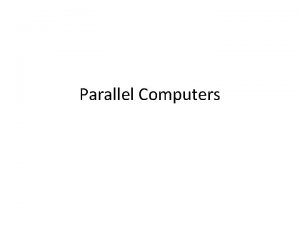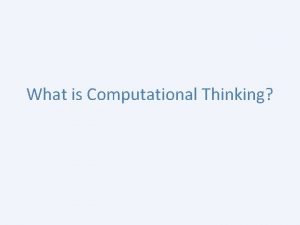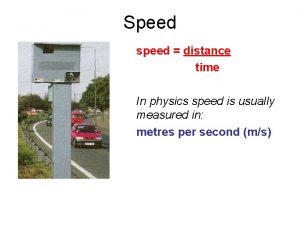Introduction Demand for Computational Speed Continual demand for









- Slides: 9

Introduction

Demand for Computational Speed • Continual demand for greater computational speed from a computer system than is currently possible • Areas requiring great computational speed include numerical modeling and simulation of scientific and engineering problems. • Computations must be completed within a “reasonable” time period.

Grand Challenge Problems • A grand challenge problem is one that cannot be solved in a reasonable amount of time with today’s computers. • Obviously, an execution time of 10 years is always unreasonable. • Examples • Modeling large DNA structures • Global weather forecasting • Modeling motion of astronomical bodies.

Global Weather Forcast Example

Parallel Computing Using more than one computer, or a computer with more than one processor, to solve a problem. Motives Usually faster computation - very simple idea - that n computers operating simultaneously can achieve the result n times faster – it will not be n times faster for various reasons.

CSI’s HPC Systems • “SALK” : a Cray XE 6 m with a total of 1280 processor cores. Salk is reserved for large parallel jobs, particularly those requiring more than 64 cores. Emphasis is on applications in the environmental sciences and astrophysics. Salk is named in honor of Dr. Jonas Salk, the developer of the first polio vaccine, and a City College alumnus. • “ANDY” is an SGI cluster with 744 processor cores and 96 NVIDIA Fermi processor accelerators. Andy is for jobs using 64 cores or fewer, for jobs using the NVIDIA Fermi’s, and for Gaussian jobs. Andy is named in honor of Dr. Andrew S. Grove, a City College alumnus and one of the founders of the Intel Corporation.

CSI’s HPC Systems • “BOB” is a Dell cluster with 232 processor cores. Bob is for jobs using 64 cores or fewer, and parallel Matlab jobs. Bob is named in honor of Dr. Robert E. Kahn, an alumnus of the City College, who, along with Vinton G. Cerf, invented the TCP/IP protocol. • “KARLE” is a Dell shared memory system with 24 processor cores. Karle is used for serial jobs, Matlab, SAS, parallel Mathematica, and certain ARCview jobs. Karle is named in honor of Dr. Jerome Karle, an alumnus of the City College of New York who was awarded the Nobel Prize in Chemistry in 1985.

CSI’s HPC Systems • “Zeus” is a Dell cluster with 88 processor cores. It is used for Gaussian jobs. • “Neptune” is the system that is used as a gateway to the above HPCC systems. It is not used for computations.

CSI’s HPC Systems • http: //wiki. csi. cuny. edu/cunyhpc/index. php/Main_Page#I nstalled_systems
 The computational speed of computers
The computational speed of computers Itil 7 step continuous improvement process
Itil 7 step continuous improvement process Continual service improvement metrics itil
Continual service improvement metrics itil Continual
Continual Module 5 supply and demand introduction and demand
Module 5 supply and demand introduction and demand Time speed formula
Time speed formula A narrow field of vision (140 degrees or less) is called
A narrow field of vision (140 degrees or less) is called Speed detection of moving vehicle using speed cameras ppt
Speed detection of moving vehicle using speed cameras ppt Characteristics of computational thinking
Characteristics of computational thinking Computational thinking algorithms and programming
Computational thinking algorithms and programming














